Table of Contents

Pollution of Air and Water
Paheli and Boojho were very excited to know that Taj Mahal in Agra is one of the seven wonders of the world. But they were disappointed to hear that the beauty of this monument in white marble is being threatened by air pollution in the area surrounding the Taj. They were eager to know if something can be done to control the air and water pollution.
We are all aware that our environment is not what it used to be. Our elders talk about the clean water and fresh air that was available in their times. Now the media regularly reports on the falling quality of the environment. We ourselves feel the impact of the falling quality of air and water in our lives. The number of people suffering from diseases of the respiratory system, for example, is steadily rising.
We shudder to imagine a time when clean air and water may no longer be available! You have learnt about the importance of air and water in your previous classes. In this chapter, we will study about the harmful changes taking place in our surroundings and their effects on our lives.
18.1 Air Pollution
We can survive for some time without food, but we cannot survive even for a few minutes without air. This simple fact tells us how important clean air is to us.
You already know that air consists of a mixture of gases. By volume, about 78% of this mixture is nitrogen and about 21% is oxygen. Carbon dioxide, argon, methane, ozone and water vapour are also present in very small quantities.
Activity 18.1
You may have covered your nose while passing a brick kiln emitting smoke or started coughing while walking on a busy road (Fig. 18.1). On the basis of your experience, compare the quality of air at the places given below:
- A park and a busy road.
- A residential area and an industrial area.
- A busy traffic intersection at different times of the day e.g. early morning, afternoon and evening.
- A village and a town.
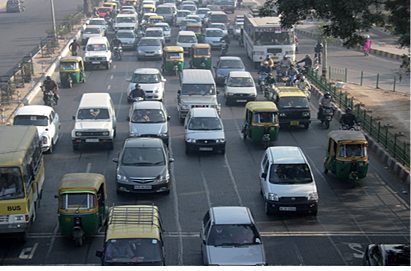
Fig. 18.1 : A congested road in a city
One of your observations in the above activity could be the differences in the amount of smoke in the atmosphere. Do you know where the smoke could have come from? Addition of such substances to the atmosphere modifies it. When air is contaminated by unwanted substances which have a harmful effect on both the living and the non-living, it is referred to as air pollution.
18.2 How does Air Get Polluted?
The substances which contaminate the air are called air pollutants. Sometimes, such substances may come from natural sources like smoke and dust arising from forest fires or volcanic eruptions. Pollutants are also added to the atmosphere by certain human activities. The sources of air pollutants are factories (Fig. 18.2), power plants, automobile exhausts and burning of firewood and dung cakes.

Fig. 18.2 : Smoke from a factory
Activity 18.2
You might have read in the newspapers that respiratory problems amongst children are rising day by day. Conduct a survey of households in your neighbourhood and among friends to find out how many children are suffering from respiratory problems.
Many respiratory problems are caused by air pollution. Let us now try to find out the substances or pollutants which are present in the polluted air.
Have you noticed how rapidly the number of vehicles is increasing in our cities?
Vehicles produce high levels of pollutants like carbon monoxide, carbon dioxide, nitrogen oxides and smoke (Fig. 18.3). Carbon monoxide is produced from incomplete burning of fuels such as petrol and diesel. It is a poisonous gas. It reduces the oxygen-carrying capacity of the blood.
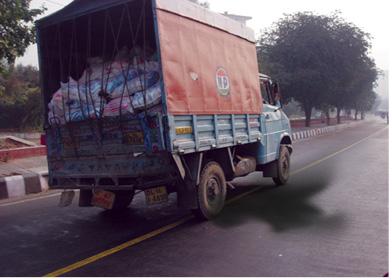
Fig. 18.3 : Air pollution due to automobiles
Do you know?
If the vehicles registered in Delhi are lined up one after the other, the total length would be nearly equal to the combined lengths of the two longest rivers in the world, Nile and Amazon!
Boojho remembers seeing a thick fog-like layer in the atmosphere, especially during winters. This is smog which is made up of smoke and fog. Smoke may contain oxides of nitrogen which combine with other air pollutants and fog to form smog. The smog causes breathing difficulties such as asthma, cough and wheezing in children.
Many industries are also responsible for causing air pollution. Petroleum refineries are a major source of gaseous pollutants like sulphur dioxide and nitrogen dioxide. Sulphur dioxide is produced by combustion of fuels like coal in power plants. It can cause respiratory problems, including permanent lung damage. You have already studied about the burning of fossil fuels in Chapter 5.
Other kinds of pollutants are chlorofluorocarbons (CFCs) which are used in refrigerators, air conditioners and aerosol sprays. CFCs damage the ozone layer of the atmosphere. Recall that the ozone layer protects us from harmful ultraviolet rays of the sun. Have you heard of the ozone hole? Try to find out about it. Thankfully, less harmful chemicals are now being used in place of CFCs.
In addition to the above mentioned gases, automobiles which burn diesel and petrol, also produce tiny particles which remain suspended in air for long periods (Fig. 18.3). They reduce visibility. When inhaled, they cause diseases. Such particles are also produced during industrial processes like steel making and mining. Power plants give out tiny ash particles which also pollute the atmosphere.
Activity 18.3
Prepare a table using the pollutants mentioned above. You may even add more data to the following Table.
Table 18.1

18.3 Case Study—The Taj Mahal
Over the past 2 decades, India’s most famous tourist attraction, Taj Mahal located in Agra (Fig. 18.4), has become a matter of concern. Experts have warned that pollutants in air are discolouring its white marble. So, it is not only living organisms that get affected by polluted air but non-living things like buildings, monuments and statues also get affected.
The industries located in and around Agra like rubber processing, automobile, chemicals and especially the Mathura oil refinery, have been responsible for producing pollutants like sulphur dioxide and nitrogen dioxide. These gases react with the water vapour present in the atmosphere to form sulphuric acid and nitric acid. The acids drop down with rain, making the rain acidic. This is called acid rain. Acid rain corrodes the marble of the monument. The phenomenon is also called “Marble cancer”. Suspended particulate matter, such as the soot particles emitted by Mathura oil refinery, has contributed towards the yellowing of the marble.
The Supreme Court has taken several steps to save the Taj. It has ordered industries to switch to cleaner fuels like CNG (Compressed Natural Gas) and LPG (Liquefied Petroleum Gas). Moreover, the automobiles should switch over to unleaded petrol in the Taj zone.
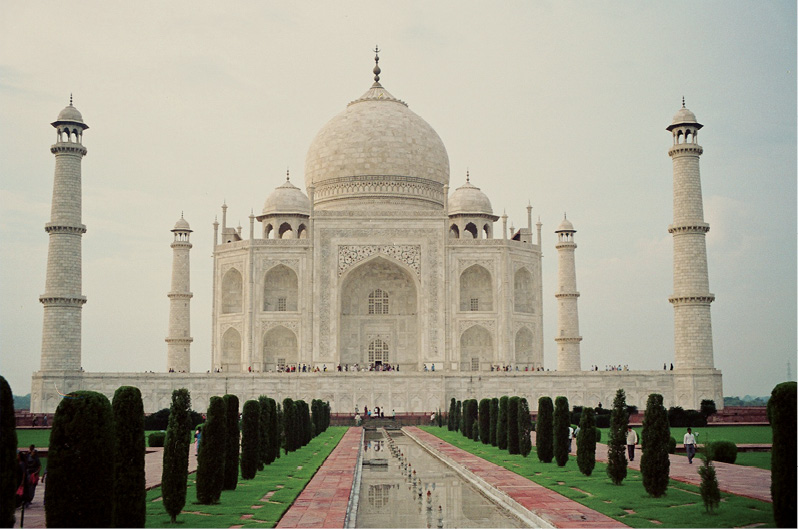
Discuss with your elders and see what they have to say about the condition of the Taj, 20 or 30 years ago! Try to procure a picture of the Taj Mahal for your scrap book.
 I am reminded of the chapter on crops. I wonder whether acid rain affects the soil and plants also.
I am reminded of the chapter on crops. I wonder whether acid rain affects the soil and plants also.
18.4 Greenhouse Effect
You know that the sun’s rays warm the earth’s surface. A part of the radiation that falls on the earth is absorbed by it and a part is reflected back into space. A part of the reflected radiation is trapped by the atmosphere. The trapped radiations further warm the earth. If you have seen a greenhouse in a nursery or elsewhere, recall that the sun’s heat is allowed to get in but is not allowed to go out. The trapped heat warms the green house. The trapping of radiations by the earth’s atmosphere is similar. That is why it is called the greenhouse effect. Without this process, life would not have been possible on the earth. But now it threatens life. Excess of CO2 in the air is one of the gases responsible for this effect.
You know that CO2 is one of the components of air. You have also studied the role of carbon dioxide in plants. But if there is excess of CO2 in the air, it acts as a pollutant.
Can you help Paheli find out the answer to her question?

But how does CO2 content rise in the atmosphere and become excessive?
On the one hand, CO2 is continuously being released because of human activities. On the other hand, area under forests is decreasing. Plants utilise CO2 from the atmosphere for photosynthesis, thereby decreasing the amount of CO2 in the air. Deforestation leads to an increase in the amount of CO2 in the air because the number of trees which consume CO2 is reduced. Human activities, thus, contribute to the accumulation of CO2 in the atmosphere. CO2 traps heat and does not allow it to escape into space. As a result, the average temperature of the earth’s atmosphere is gradually increasing. This is called global warming.
Other gases like methane, nitrous oxide and water vapour also contribute towards this effect. Like CO2, they are also called greenhouse gases.
Global Warming
A Serious Threat!
Global warming can cause sea levels to rise dramatically. In many places, coastal areas have already been flooded. Global warming could result in wide rangingeffects on rainfall patterns, agriculture, forests, plants and animals. Majority of people living in regions which are threatened by global warming are in Asia. A recent climate change report gives us only a limited time to keep the greenhouse gases at the present level. Otherwise, the temperature may rise by more than 2 degrees Celsius by the end of the century, a level considered dangerous.
Global warming has become a major concern for governments worldwide. Many countries have reached an agreement to reduce the emission of greenhouse gases. The Kyoto Protocol is one such agreement.
Boojho is surprised to hear that an increase in the earth’s temperature by even as little as 0.5 °C can have such a serious effect! Paheli tells him that she had read in the newspapers recently that the Gangotri glacier in the Himalayas has started melting because of global warming.
18.5 What can be Done?
What can we do to reduce air pollution?
There are many success stories in our fight against air pollution. For example, a few years ago, Delhi was one of the most polluted cities in the world. It was being choked by fumes released from automobiles running on diesel and petrol. A decision was taken to switch to fuels like CNG (Fig. 18.5) and unleaded petrol. These measures have resulted in cleaner air for the city. You might know of some other examples from your area regarding reduction of air pollution. Share these with your friends.
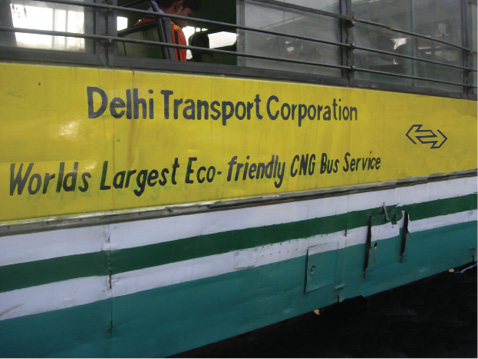
Fig. 18.5 : A public transport bus powered by CNG
The quality of air at various locations is monitored regularly by government and other agencies. We can use this data to generate awareness about air pollution among friends and neighbours.
Do you know about the “Say no to crackers” campaign which was organised by children from many schools? This made a big difference to the air pollution levels around Diwali.
There is a need to switch over to alternative fuels instead of the fossil fuels for our energy requirements. These could be solar energy, hydropower and wind energy.
Activity 18.4
You have various options of commuting to your school such as walking, going by bicycle, travelling by bus or other public transport, using a car individually, travelling by car pool. Discuss in your class the impact of each of these options on the quality of air.
Small contributions on our part can make a huge difference in the state of the environment. We can plant trees and nurture the ones already present in the neighbourhood. Do you know about Van Mahotsav, when lakhs of trees are planted in July every year (Fig. 18.6)?
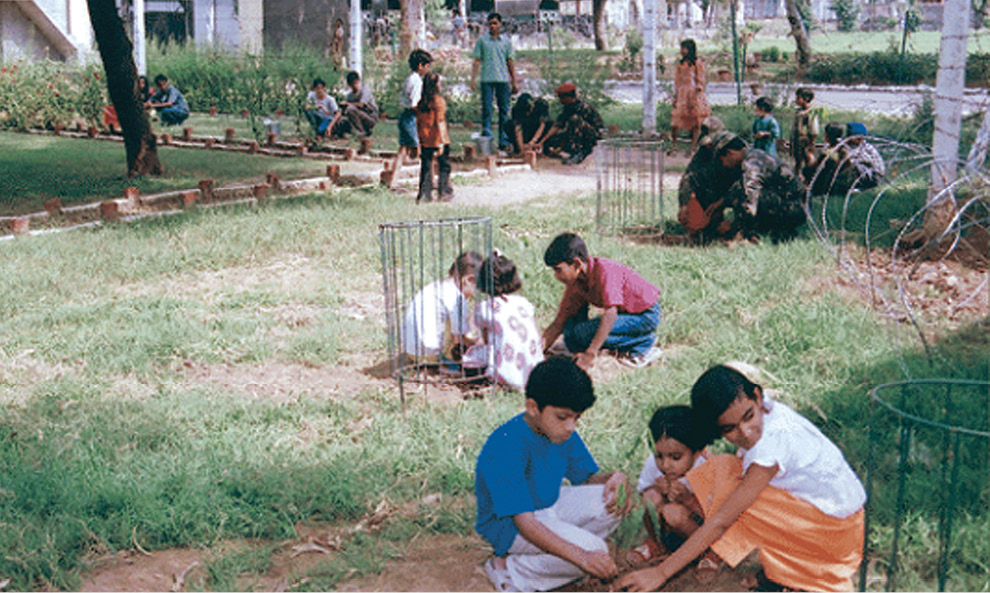
Fig. 18.6 : Children planting saplings
Boojho and Paheli once happened to go to an area where some people were burning dry leaves. They started coughing because the entire area was full of smoke. Paheli thought it would be a better option to put them in a compost pit rather than burning. What do you think?
18.6 Water Pollution
In Class VII you learnt that water is a precious resource. Think and list the various activities in which we need water. We saw that water is becoming scarce due to increase in population, industries and agricultural activities. You have also studied how water becomes “dirty” after we use it for washing clothes, bathing, etc. This means that we are adding some materials to the water, which spoil its quality and change its smell and colour.
Whenever harmful substances such as sewage, toxic chemicals, silt, etc., get mixed with water, the water becomes polluted. The substances that pollute water are called water pollutants.
Activity 18.5
Try to collect samples of water from a tap, pond, river, well and lake. Pour each into separate glass containers. Compare these for smell, acidity and colour. Complete the following Table.
Table 18.2
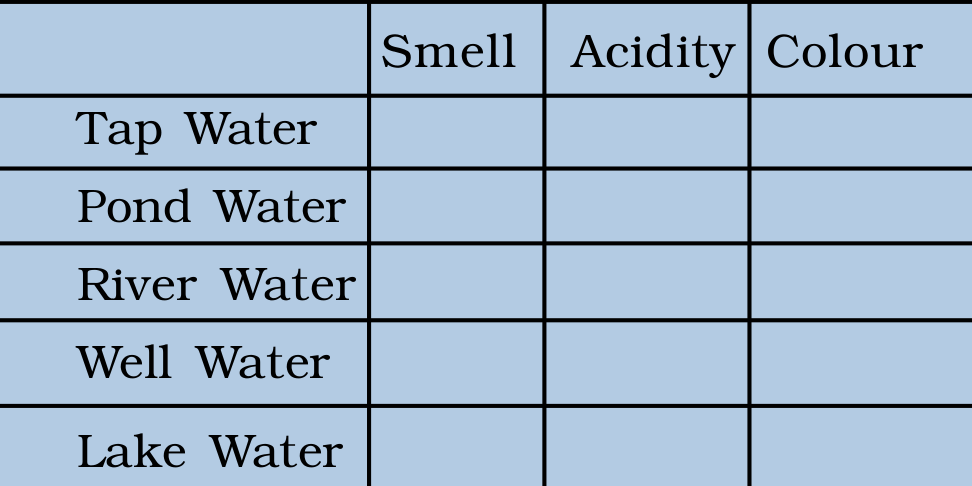
18.7 How does Water Get Polluted?
Case Study
Ganga is one of the most famous rivers of India (Fig. 18.7). It sustains most of the northern, central and eastern Indian population. Millions of people depend on it for their daily needs and livelihood. However, recently a study by the World Wide Fund for Nature (WWF) found that Ganga is one of the ten most endangered rivers in the world. The pollution levels have been rising for many years. We have reached this stage because the towns and cities, through which the river flows, throw large quantities of garbage, untreated sewage, dead bodies, and many other harmful things, directly into the river. In fact the river is ‘dead’ at many places where the pollution levels are so high that aquatic life cannot survive.

Fig. 18.7 : Course of the river Ganga
An ambitious plan to save the river, called the Ganga Action Plan was launched in 1985. It aimed to reduce the pollution levels in the river. However, the increasing population and industrialisation have already damaged this mighty river beyond repair. Now, the Government of India has launched a new initiative known as National Mission for Clean Ganga (NMCG) in 2016.
Let us take a specific example to understand the situation. The Ganga at Kanpur in Uttar Pradesh (U.P.), has one of the most polluted stretches of the river (Fig. 18.8). Kanpur is one of the most populated towns in U.P. People can be seen bathing, washing clothes and defecating in the river. They also throw garbage, flowers, idols of gods and goddesses and non-biodegradable polythene bags into the river.
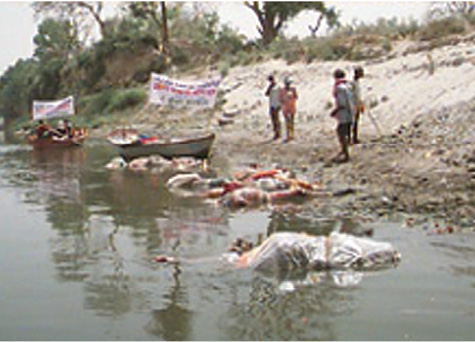
Fig. 18.8 : A polluted stretch of the river Ganga
At Kanpur the amount of water is comparatively small and the flow of the river is very slow. In addition, Kanpur has more than 5000 industries. These include fertiliser, detergent, leather and paint industries. These industrial units discharge toxic chemical wastes into the river.
Based on the above information think of the answers to the following questions –
What are the factors responsible for pollution of the river ?
What steps can be taken to restore the river Ganga to its past glory ?
How would the disposal of garbage, etc., affect the living organisms in the river ?
Many industries discharge harmful chemicals into rivers and streams, causing the pollution of water
(Fig. 18.9). Examples are oil refineries, paper factories, textile and sugar mills and chemical factories. These industries cause chemical contamination of water. The chemicals released include arsenic, lead and fluorides which lead to toxicity in plants and animals. There are regulations to prevent this. Industries are supposed to treat the waste produced before discharging it into waters, but quite often the rules are not followed. The soil is also affected by impure water, causing changes in acidity, growth of worms, etc.
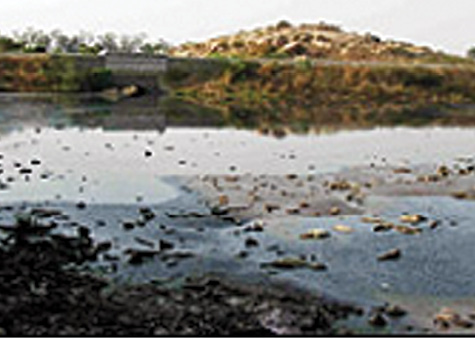
Fig. 18.9 : Industrial waste discharged into a river
We have learnt in Chapter 1 the importance of pesticides and weedicides for the protection of crops. However, all these chemicals dissolve in water and are washed into water bodies from the fields. They also seep into the ground to pollute ground water.
Have you seen ponds which look green from a distance because they have a lot of algae growing in them? This is caused by excessive quantities of chemicals which get washed from the fields. These act as nutrients for algae to flourish. Once these algae die, they serve as food for decomposers like bacteria. A lot of oxygen in the water body gets used up. This results in a decrease in the oxygen level which may kill aquatic organisms.
Recall Activity 18.6
You had investigated the sewage disposal system of your locality in Class VII.
Do you remember how the sewage was collected from your home and where it went thereafter?
Sometimes untreated sewage is thrown directly into rivers. It contains food wastes, detergents, microor-ganisms, etc. Can ground water get polluted by sewage? How? Water contaminated with sewage may contain bacteria, viruses, fungi and parasites which cause diseases like cholera, typhoid and jaundice.
The bacteria present in the faeces of mammals are indicators of the quality of water. If water has these bacteria, it means that it has been contaminated by fecal matter. If such water is used by us, it can cause various infections.
Do you know?
Hot water can also be a pollutant ! This is usually water from power plants and industries. It is released into the rivers. It raises the temperature of the waterbody, adversely affecting the animals and plants living in it.
18.8 What is Potable Water and How is Water Purified ?
Activity 18.7
Let us construct a water filter with simple, everyday materials.
Take a plastic bottle and cut it into 2 halves at the centre. Use the upper half as a funnel by putting it upside down in the lower half. Make layers in it with paper napkin or a fine cloth followed by, cotton, sand and then gravel. Now pour dirty water through the filter and observe the filtered water.
Discuss the following questions amongst yourselves and with your teacher:
- Why do we need to filter water before drinking ?
- Where do you get your drinking water from?
- What will happen if we drink polluted water?
Boojho is very upset. He tells Paheli that he drank water which looked clear and was without any smell, but still he fell sick !
Paheli explains that water which looks clean may still have disease-carrying microorganisms and dissolved impurities. So, it is essential to purify water before drinking, for example, by boiling.
Water which is suitable for drinking is called potable water. You have seen how various physical and chemical processes in the sewage treatment plants help to clean water before discharging it into water bodies. Similarly, municipal bodies treat the water before supplying it to households.
Do you know?
25% of the world’s population is without safe drinking water !
Let us see how water can be made safe for drinking:
You have already seen how water is filtered. This is a physical method of removing impurities. A popular household filter is a candle type filter.
Many households use boiling as a method for obtaining safe drinking water. Boiling kills the germs present in the water.
Chlorination is a commonly used chemical method for purifying water. It is done by adding chlorine tablets or bleaching powder to the water. We must be cautious. We should not use more chlorine tablets than specified.
18.9 What Can be Done?
Activity 18.8
Investigate the level of awareness about water pollution in your area. Collect data on the sources of drinking water and the methods of sewage disposal.
What are the common water-borne diseases in the community? You can consult your local doctor/health worker for this.
Which are the governmental and non-governmental organisations working in this field? What are the measures being taken by them for generating awareness?
Laws for industrial units should be strictly implemented so that polluted water is not disposed off directly into rivers and lakes. Water treatment plants should be installed in all industrial areas (Fig. 18.10). At our individual levels we should consciously save water and not waste it. Reduce, reuse and recycle should be our mantra !
Think of your daily routine – how can you save water?
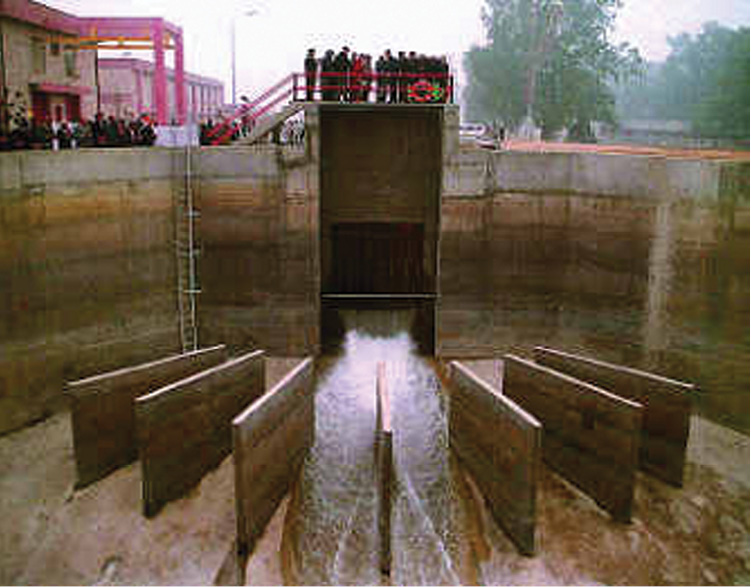
Fig. 18.10 : Water treatment plant
We can think of creative ideas like reusing water used for washing and for other household tasks. For example, water used for washing vegetables may be used to water plants in the garden.
Pollution is no longer a distant phenomenon. It is affecting the quality of our daily lives. Unless we all realise our responsibility and start using environment-friendly processes, the very survival of our planet is in danger.
Do you know?
While brushing your teeth, leaving the tap running may waste several litres of water. A tap that drips once every second wastes a few thousand litres of water every year. Think about it !
Keywords
Air Pollution
Chemical contamination
Global warming
Greenhouse effect
Pollutants
Potable water
Water Pollution
WHAT YOU HAVE LEARNT
- Air pollution is the contamination of air by impurities which may have a harmful impact on the living organisms and the non-living components.
- Pollutants are the substances which contaminate air and water.
- Carbon monoxide, nitrogen oxides, carbon dioxide, methane and sulphur dioxide are the major pollutants of air.
- Increasing levels of greenhouse gases like CO2 are leading to global warming.
- Water pollution is the contamination of water by substances harmful to life.
- Sewage, agricultural chemicals and industrial waste are some of the major contaminants of water.
- Water which is purified and fit for drinking is known as potable water.
- Water is a precious natural resource. We must learn to conserve it.
Exercises
1. What are the different ways in which water gets contaminated ?
2. At an individual level, how can you help reduce air pollution?
3. Clear, transparent water is always fit for drinking. Comment.
4. You are a member of the municipal body of your town.
Make a list of measures that would help your town to ensure the supply of clean water to all its residents.
5. Explain the differences between pure air and polluted air.
6. Explain circumstances leading to acid rain. How does acid rain affect us?
7. Which of the following is not a greenhouse gas?
(a) Carbon dioxide
(b) Sulphur dioxide
(c) Methane
(d Nitrogen
8. Describe the ‘Green House Effect’ in your own words.
9. Prepare a brief speech on global warming. You have to deliver the speech in your class.
10. Describe the threat to the beauty of the Taj Mahal.
11. Why does the increased level of nutrients in the water affect the survival of aquatic organisms?
Extended Learning — Activities and Projects
1. In some cities, a pollution check has been made compulsory for vehicles. Visit a petrol pump in order to learn about the process of conducting a pollution check. You may systematically record your findings in the following areas:
- Average number of vehicles checked per month.
- Time taken to check each vehicle.
- Pollutants checked for.
- The process of testing.
- Permissible levels of emission of various gases.
- Measures taken if the emitted gases are above the permissible limits.
- How frequently is a pollution check required ?
2. Conduct a survey in your school to investigate various environment related activities that have been undertaken. The class can divide itself into two groups, with each group looking at a different area. For example, one group can find out whether there is an environment club in the school. What are its objectives ? What is its calendar of events ? How can you become a member ?
If your school does not have such a club, you even think of starting one along with a few of your friends.
3. Organise a field visit to a river in or around your town with the help of your teachers.
Observations followed by discussion could focus on
- the history of the river.
- cultural traditions.
- role of the river in meeting the town’s water needs.
- pollution concerns.
- sources of pollution.
- effects of pollution on the people living by the riverside as well as those living far away.
4. Find out with the help of your teachers and the internet (if possible), whetherthere are any international agreements to control global warming. Which are the gases covered under these agreements?
- www.edugreen.teri.res.in/explore/air/air.htm
- www.edugreen.teri.res.in/explore/water/pollu.htm
- www.cpcb.nic.in/citizenís%Charter/default_citizenís.html
- coe.mse.ac.in/kidswater.asp
- coe.mse.ac.in/kidsair.asp
